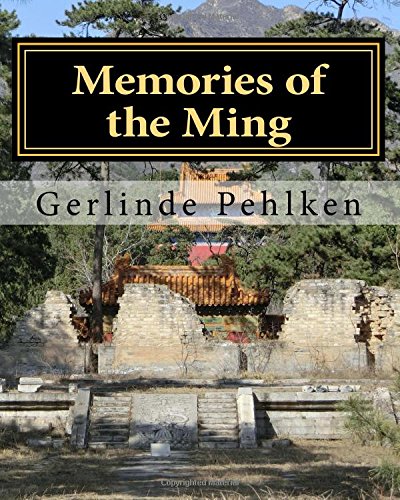I lived in Xisanqi, a district in the north of Beijing, between 1994 and 1998. Early on Chinese friends invited us to visit famous sight-seeing spots with us. We went to Badaling to see the Great Wall riding on top the mountain ridges, and in passing we also visited the Sacred Road and the Changling tomb. After seeing so many wonders in one day we hardly realized what we were looking at. One of our friends, Mr. Li, told me the history of the Ming emperors in a few sentences. In Spring 1995 my husband’s company gave us a car, and at the same time both of us received Chinese driving licenses. Having relied on bus and taxi until then, we now looked forward to excursions by car. On a weekend in May 1995 our American friends invited us to a picnic. Driving in a northern direction, the foreign community met in a walled garde; the Germans brought potato salad, the Italians pasta, the French contributed baguettes, the English roast-beef and the Americans burgers. After a pleasant meal I asked for the name of this place. Shisanling, I was told.
Shisanling, that sounded familiar. We started to explore the area, and I discovered a great terrace. My husband climbed a tower over almost destroyed stairs while I stood on the terrace, images of last year flashing before my eyes. All this I had seen before.The area was a smaller version of the Changling tomb we had visited several months ago with our friends. Only this place was much more decayed, some buildings didn’t even exist any more. Our friends had no idea that they were standing on a tomb.
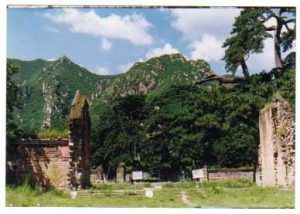
The next weekend we returned to visit once more the imposing Changling. In a small store I bought some books about the area, and the same day we also had another look at the other tomb. After the noise and bustle in the Changling it felt especially quiet here, only the birds were singing. So this was the valley where the dead Ming emperors rested. Here they had built their palaces for the afterlife, some larger and some smaller. During my Chinese lessons I looked at the characters for Shisanling and recognized the number 13. This meant that there were 11 more tombs to be found in this valley, and from that day on we often went there to find not only the imperial tombs, but also burials sites of eunuchs and concubines. After searching for a long time I found the burial site of the Jingtai Emperor in the western mountains. Only in 1999 I visited the tomb of the first Ming emperor in Nanjing. Three of the tombs in Shisanling – besides the Changling these are the Dingling with its underground chamber and the small Zhaoling – are open to the public. The remaining ten tombs have been partially restored; gates have been installed which prevent visitors from entering. My impressions, put down in this book, date mostly from the years 1995 to 1998. In March 1961 the Imperial Tombs of the Ming Dynasty were placed under state protection, and since July 2003 they are listed as a UNESCO World Heritage site. On my last visit in March 2016 I found many changes; renovations were carried out in many places. The memories of the Ming are being preserved for future generations.
The tombs of the Ming emperors
Historical records name eighteen tombs of the Ming Dynasty, even though there were only sixteen emperors. The Hongwu Emperor built a mausoleum named Huangling for his parents in Fengyang, Anhui Province, and another tomb (Zhuling) for his grandfather and further ancestors in Jiangsu Province. The emperor himself was buried near his capital Nanjing, next to the vermilion gold mountain. Nanjing had been the capital of China before, during the Time of Six Dynasties (265-589). His tomb is called Xiaoling. The burial site of the second Ming emperor, the Jianwen Emperor, is unknown. Many historians believe that he was buried together with his wife and a son in the area of the Xiaoling tomb.

All other emperors of the Ming dynasty were buried north of Beijing because the Yongle Emperor moved his capital there in 1421. Even though he was ruler of China, the Jingtai Emperor was not buried in Shisanling. Because he usurped the throne he received only the burial of a prince of first rank in the western mountains. The parents of the Jiajing Emperor also received an imperial burial, the Xianling in Zhongxian, Hubei Province. The Jiajing Emperor started a new line of the Ming dynasty because his predecessor died without children.
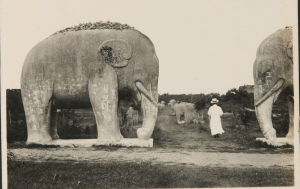
Shisanling
The road from Beijing to Changping leads through many small villages. Behind the first village, named Shahe, stands a stele on a turtle on the northern bank of the river. A few hundred metres further on there is a second stele to the left side of the road. After crossing the 6th Ring Road and the Jingmi Canal the road comes to a roundabout with a statue in the centre. The statue depicts Li Zicheng (1606-1645), the rebel leader who was responsible for the overthrow of the Ming dynasty. Before being moved her in 1996 the statue stood in the village of Qinghe in Haidian district. Further along the road, as the first indication that the tombs are near, stands a large Pailou (memorial gate). There are claims that this Pailou is the largest and most beautiful of its kind in all of China. It consists of six columns, each made from a single block of marble. These columns are connected by marble lintels to form five arches. Each lintel has a frieze decorated with a cloud pattern except the middle one, where the frieze is smooth, probably to place an inscription there.
The Pailou is 5.5 metres high and 34 metres long and has a roof that is a perfect replica of a traditional Chinese roof done in marble. Probably the whole construction was painted to resemble traditional architecture even more; bits of red or green paint can still be seen in protected spots. The bases for the columns are made from darker stone and measure 1.5 metres in every direction. The two outer bases show two lions playing with a pearl, the middle bases show the steed Makara from Hindu mythology, and the inner pair displays dragons. The Pailou was constructed in 1540 by the Jiajing Emperor to commemorate the glorious Ming dynasty. At this time the area was more than a hundred years old and already contained seven tombs.
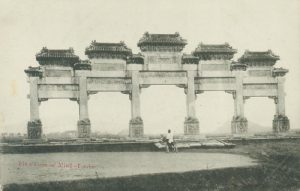
One kilometre behind the Pailou stands the Dahongmen (Large Red Gate). It was built in 1425 by a son of the famous Yongle Emperor. This gate is the actual entrance to the burial area. Old records speak of a wall that was twelve kilometres long and had ten passes with defensive towers for the tomb guards. Today no trace of this wall is left except for two short pieces at the sides of the Dahongmen.
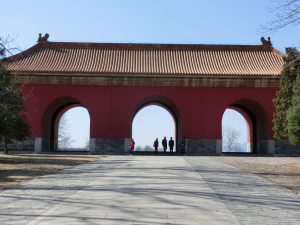
The gate is painted in the same deep red as the walls in the Forbidden City and the roof is tiled in imperial yellow. It has three arches: the middle arch was reserved for the dead emperor on the day of his burial, the left arch was used by the living emperors coming to honour their ancestors. The right arch was used by officials. The gate had large wooden doors, and the hinges can still be seen today. In 1890 there was no trace of gates left, while in 1931 a visitor wrote of seeing the doors in place. In front of the Dahongmen stand two steles that are inscribed with an order to all visitors to dismount from their horses. Even the emperors themselves walked from this point on to show their respect to the dead. During the Qing dynasty ignoring this rule was punished by 100 lashes with a long bamboo stick. From the Dahongmen a road led to every single tomb. Until the 1990s traffic passed through the two outer arches of the Red Gate. Then a new road was constructed that leads around the gate and the Sacred Road that follows it.
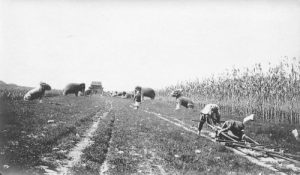
The Sacred Road
500 metres behind the Dahongmen stands a square pavilion that measures 26 metres on all sides. The pavilion has been restored, because a photograph from 1890 shows the roof in very bad condition. The pavilion stands on a platform. The floor inside is made from red-streaked marble, and in the centre stands a stele commemorating the dead Ming emperors. This stele is more than ten metres high and stands on the back of a legendary giant turtle named Ao. The turtle itself is 4.5 metres long, 2.5 metres wide and 1.8 metres high, carved from a single block of stone and resting on a foundation decorated with waves.
The custom to erect a stele in front of a tomb to praise the virtues of the dead goes back to the times of the Han dynasty. The stele is topped with the dragon son Bixi. On the front the Hongxi Emperor had a poem engraved in praise of his father, recounting the virtues and deeds of the Yongle Emperor. In 1538 the Jiajing Emperor wanted to change the inscription, but this was no easy task. Permissions had to be given by the Tribunal of Customs and by the Hanlin Academy. Finally a date was set, but the new inscription was never carved on the stele. In 1604 the stele was hit by lightning. The advisers of the Wanli Emperor claimed that now was the right time for a change because the stele had to be repaired. The emperor, however, grew angry, stating that Heaven would be displeased. Thus the inscription remained unchanged. On the back side of the stele is a poem by the Qianlong Emperor of the Qing dynasty which he wrote in 1785. It is titled “Elegy of the 13 Ming tombs” and speaks of the unreasonableness of the Ming emperors. He writes about their neglecting their duties and describes the current bad state of the compound which makes him sad. On the left side is another poem by the Qianlong Emperor, speaking about the repairs done by him and describing his thoughts about growth and decline of the Ming dynasty. The right side of the stele is inscribed with a poem by the Jiaqing Emperor written in 1804, telling us about the decline of the Ming dynasty.
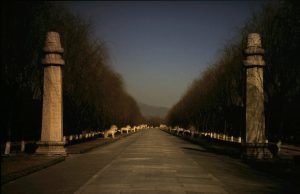
The large pavilion is flanked by four ornamental columns called Huabiao. Columns in the same style can also be seen at the northern entrance to the Forbidden City and in front of the Tiananmen. On top of each column sits a mythical beast called Wangtianhou (look at the sky and shout), looking out for the emperor whenever he left the palace. The Huabiao have a long tradition in China. During the Han dynasty the columns were made of wood and rectangular instead of round. They were used to display notices which were either attached to the column or directly written on it. So the Huabiao formed an early information network. They were also known by two other names. One of these is Qingtianzhu (pillar supporting the sky), the other ancient name is Feibangmu (wood to express your opinion). Later, during the Tang dynasty, these columns were still in use, but now people started to recreate them in stone and place them in front of important buildings. The column is set on an octagonal base with six layers decorated with dragons and lotus leaves. A dragon is twined around the column, looking up to the sky. The Wangtianhou on top are looking away from each other: the beasts on the southern columns look south, those on the northern columns look north. Near the top of the column is a wing-like extension attached whose meaning is unclear. It may refer to the posting system of earlier times and indicate the speed at which messages spread through the land. Or it may symbolise clouds produced by the dragon on the column. The “wing” is called Chuanyunban (plate going through the cloud). Behind the red pavilion stand two Wangzhu, hexagonal high columns that always mark the beginning of a Sacred Road. These columns served a double purpose: they should call the wandering spirit home and nourish it. The Chinese believe that nature is composed of two fundamental opposing principles named Yin and Yang. Yang is the male element, including warmth, light and the sky. Yin is the female principle, the earth, darkness, coldness and death. The human soul is Yang while the body is Yin. Common belief was that the soul could never find its body without the Wangzhu showing the way. At the same time the Wangzhu should feed the soul with light and warmth. The belief that a flame nourishes the soul is also present in the burial chamber: here we find an “eternal light” that was lighted just before the chamber was closed.

Right after the Wangzhu begins a 1,100 metre long road flanked by 24 stone animals and twelve imperial officials. They are placed in pairs facing each other. Every animal is present four times: one sitting pair and one standing pair. A legend claims that at midnight the two pairs change places. Always the standing pair is closest to the tombs. All the figures are carved from a single block; the largest is 3.4 metres high and 4.5 metres long.
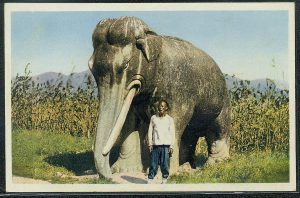
The animals are a mix of real creatures and mythical beasts. They stand in the following order: lion, Xiezhi, camel, elephant, Qilin, horse. The camels, horses and elephants are certainly present for practical purposes, standing ready to serve the emperor even in death. Camels were used in northern China as beasts of burden up to the middle of the 20th century. The horses do not look like the Tang dynasty sculptures with long legs and a narrow head, but with their robust build are more reminiscent of Mongolian horses. Elephants were also commonly used to transport goods in China.
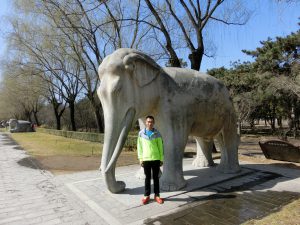
In 1884 an elephant escaped and fled down a street, throwing an old woman over the roof of a house. Then he grabbed a donkey cart with his trunk and threw it into a shop. After this incident elephants became less common as beasts of burden. The idea of having a lion as a guardian of sacred buildings came to China with Buddhism. The lion is not native to China but was imported from Persia. The lions at the Sacred Road wear beautifully decorated collars.

If you are interested in learning more about the Ming tombs and their history, you can find further information here:
